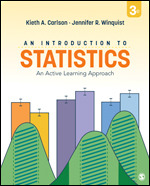An Introduction to Statistics
An Active Learning Approach
Third Edition
- Kieth A. Carlson - Valparaiso University, USA
- Jennifer R. Winquist - Valparaiso University, USA
December 2020 | 512 pages | SAGE Publications, Inc
This updated and reorganized Third Edition of this textbook takes a workbook-style approach that encourages an active approach to learning statistics. Carefully placed reading questions throughout each chapter allow students to apply their knowledge right away, while in-depth activities based on current behavioral science scenarios, each with problem sets and quiz questions, give students the opportunity to assess their understanding of concepts while reading detailed explanations of more complex statistical concepts. Additional practice problems further solidify student learning. Most activities are self-correcting, so if a concept is misunderstood, this misunderstanding is corrected early in the learning process. After working through each chapter, students are far more likely to understand the material than when they only read the material.
Watch a video from the authors on the new edition here!
Watch a video from the authors on the new edition here!
Preface
Acknowledgments
About the Authors
Part 1: Descriptive Statistics and Sampling Error
Chapter 1: Introduction to Statistics and Frequency Distributions
Chapter 2: Central Tendency and Variability
Chapter 3: z scores
Chapter 4: Sampling Error and Confidence Intervals with z and t Distributions
Part 2: Applying the Four Pillars of Scientific Reasoning to Mean Differences
Chapter 5: Single sample t, effect sizes, and confidence intervals
Chapter 6: Related samples t, effect sizes, and confidence intervals
Chapter 7: Independent samples t, effect sizes, and confidence intervals
Chapter 8: One-way ANOVA, effect sizes, and confidence intervals
Chapter 9: Two-way ANOVA, effect sizes, and confidence intervals
Part 3: Applying the Four Pillars of Scientific Reasoning to Associations
Chapter 10: Correlations, effect sizes, and confidence intervals
Chapter 11: Chi square and effect sizes
Supplements
Instructor Resource Site
edge.sagepub.com/carlson3e
For additional information, custom options, or to request a personalized walkthrough of these resources, please contact your sales representative.
LMS cartridge included with this title for use in Blackboard, Canvas, Brightspace by Desire2Learn (D2L), and Moodle
The LMS cartridge makes it easy to import this title’s instructor resources into your learning management system (LMS). These resources include:
You can still access all of the same online resources for this title via the password-protected Instructor Resource Site.
edge.sagepub.com/carlson3e
For additional information, custom options, or to request a personalized walkthrough of these resources, please contact your sales representative.
LMS cartridge included with this title for use in Blackboard, Canvas, Brightspace by Desire2Learn (D2L), and Moodle
The LMS cartridge makes it easy to import this title’s instructor resources into your learning management system (LMS). These resources include:
- Test bank
- Editable chapter-specific PowerPoint® slides
- Answers to the textbook’s Reading Questions
- Answers to the textbook’s Activity Questions
- Additional Practice Tests and Answers
- All tables and figures from the textbook
You can still access all of the same online resources for this title via the password-protected Instructor Resource Site.
Student study site
edge.sagepub.com/carlson3e
For additional information, custom options, or to request a personalized walkthrough of these resources, please contact your sales representative.
LMS cartridge included with this title for use in Blackboard, Canvas, Brightspace by Desire2Learn (D2L), and Moodle
The LMS cartridge makes it easy to import this title’s instructor resources into your learning management system (LMS). These resources include:
You can still access all of the same online resources for this title via the password-protected Instructor Resource Site.
edge.sagepub.com/carlson3e
For additional information, custom options, or to request a personalized walkthrough of these resources, please contact your sales representative.
LMS cartridge included with this title for use in Blackboard, Canvas, Brightspace by Desire2Learn (D2L), and Moodle
The LMS cartridge makes it easy to import this title’s instructor resources into your learning management system (LMS). These resources include:
- Test bank
- Editable chapter-specific PowerPoint® slides
- Answers to the textbook’s Reading Questions
- Answers to the textbook’s Activity Questions
- Additional Practice Tests and Answers
- All tables and figures from the textbook
You can still access all of the same online resources for this title via the password-protected Instructor Resource Site.
I like the way the author goes to great lengths to explain concepts in ways students should understand. I think this will also be easy for me to use in the classroom.
School of Nursing, Loyola University-New Orleans
May 26, 2022
Sample Materials & Chapters
Chapter 1: Introduction to Statistics and Frequency Distributions
Chapter 2: Central Tendency and Variability


